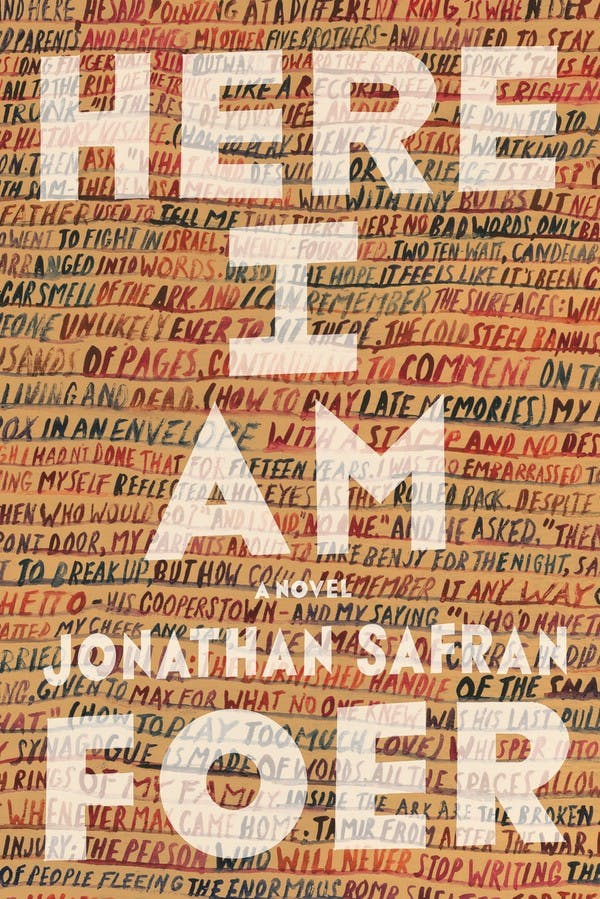
You can’t make a woman come just by looking at her. Or so it seemed we all agreed, until the arrival of Here I Am, Jonathan Safran Foer’s new novel. This is a book about a marriage falling apart, but we are granted a single window into the lives of Julia and Jacob Bloch before they tie the knot. Once upon a time, they stayed in a nice Pennsylvania hotel, and Julia asked Jacob to stare into her vagina until, well, you know. “I have this desire,” she says, improbably, at the start of the routine. It is very important to her author that this all be framed as her choice.
Not too much later, Julia decides to masturbate with a stolen bespoke doorknob. She is reported to like “how the warm metal began to stick to her skin, to pull at it a little each time.” This is a novel that makes you puzzle over small questions, not least of them the science of this particular claim. How warm, exactly, would the metal have to be for skin to be “pulled” by it? How long, exactly, does warm water actually last as a lubricant, since we are told that this is all Julia uses?
Novelists get a pass on an odd erotic claim or two, if only because imagination ought to have some place in sex. But Foer’s idiosyncratic imaginings of female sexuality are made worse when accompanied by statements like, “Every architect has fantasies of building her own home, and so does every woman.” This is the only masturbation scene Julia gets. We are treated to Jacob’s fantasies at greater length, though his sexuality boils down to a penis fixation so strong that a minor subplot of the novel sees him wondering if Steven Spielberg is uncircumcised.
It’s hard to say whether Here I Am is serious about any of this. Foer splices these sex scenes into a bourgeois family fantasy, set in a bourgeois neighborhood in Washington, D.C. Jacob works in television, and Julia is an architect. Their children are precocious in a J.D. Salinger sort of way. The middle child, nine, is prone to observations like, “You realize that’s not even honey. That’s agave.” The twelve-year-old turns his talents to the manufacture of an “artificial vagina” from a toilet-paper roll, rubber bands, Saran Wrap, and maple syrup.
Eventually their family romance is disrupted: first by Jacob and Julia’s impending divorce, set off by her discovery that he has been sexting “one of the directors” at his prestige cable television show. Then a major earthquake hits Israel, because no Foer novel is complete without the functional use of a grave historical moment. In Everything Is Illuminated, it was the Holocaust; in Extremely Loud and Incredibly Close, the September 11 attacks. Jacob spends several chapters mulling whether he will go to Israel to help with the relief effort. Ultimately, he doesn’t, and the disaster proves irrelevant to his personal drama. Slice out the newsworthy catastrophe and you’d have almost exactly the same book.

Typically, we don’t think of the kind of success that Foer has achieved as a punishment. But as one burrows deeper into Here I Am, the solipsism of a gilded life becomes stifling. Anointed fiction’s Next Big Thing in his early twenties, Foer sold his first novel, Everything Is Illuminated, for half a million dollars. When it was published in 2002, the critical praise was rhapsodic: “Not since Anthony Burgess’s novel A Clockwork Orange has the English language been simultaneously mauled and energized with such brilliance and such brio,” etc.
Later, Foer married another serious novelist and purchased an enormous Brooklyn brownstone. His second novel, deemed less thrilling, still sold well. Both novels were made into movies; the actress and fellow wunderkind Natalie Portman found his third book, Eating Animals, so powerful that she became a vegan. Foer is now divorced. All of this is Googleable history.
One likes to keep details of the author’s personal life out of criticism, but Foer has always been set on inviting readers to evaluate him personally. In Everything Is Illuminated, one of the main characters is named after himself, and he is happy to admit the biographical parallels in interview after interview. More recently, Foer published some of literary history’s most fatuous correspondence between himself and, yes, Natalie Portman in T Magazine. “How do you think about freedom?” he asks. “When do you most strongly wish you had more of it? When do you most strongly wish you had less?” If he is unhappy to be the subject of celebrity gossip, he has an odd way of showing it.
Just look at the title of this latest novel. The publisher’s materials are at pains to point out that “Here I am” is a Biblical quotation, evidently hoping to brush off some of the autobiographical implications. It is, indeed, what Abraham says to God after God has tested him, to demonstrate his continued faith. But it’s hard to resist the reading that this is Foer serving himself up in yet another thinly fictionalized form. His characters live in a large house they love in a well-to-do area of Washington, D.C. But no one in their world seems aware of the existence of government and power nearby. Their problems are the problems of the moneyed creative class—i.e., how to derive meaning and love from a world that seems to be structured against the development of either thing. In other words, they are gentrified Brooklyn problems.
Foer writes in the certainty that all of humanity shares universal experiences, so for him the particulars are often irrelevant, which feels like the most Brooklyn thing about him. He doesn’t tell us what Jacob’s show is about, nor anything about the woman he has been illicitly texting. We learn that Jacob’s sole satisfaction lies in secretly writing an autobiographical television show—not that we discover much about it. In focusing on grand, poetic truths about “freedom,” “passion,” and “loneliness,” Foer misses out on the real complications of life.
Maybe that’s a blessing. When Foer does try to address large questions, he is able to deliver only clichés in response, and not particularly resonant clichés at that. He is unduly fond of the infelicitous word “aloneness.” “Aloneness isn’t loneliness,” a secondary character informs Julia, and indeed it isn’t, but somehow the word keeps cropping up anyway. “Between any two beings there is a unique, uncrossable distance, an unenterable sanctuary,” he writes. “Sometimes it takes the shape of aloneness. Sometimes it takes the shape of love.”
That last remark is inspired by a dog, rather than a person, and the observation is not made in jest: Fellow pet owners will certainly understand. But following the earthquake and Jacob’s decision not to help out in Israel, this dollar-store insight is confusing. It is the work of a writer too practiced in the painfully self-conscious performance of exuberance and Hollywood-style big emotions, uninterested in the larger territory he lives in.
Foer’s novel has the same shortcomings as a lot of contemporary American writing. Elif Batuman once proposed that writers didn’t read enough great literature in MFA programs, but the echo-chamber problem goes further than that. Many literary writers cloister themselves from an early age, when they either study writing under already-established authors, or immerse themselves in the hierarchies of New York’s magazine and book publishing industries. The Brooklyn literary journal n+1 called this split in American literary culture “MFA vs. NYC,” and celebrated it with an anthology of essays on the subject. The dominant question is always which route is the more favorable. But we discuss much less frequently the possibility that two such narrowly defined career paths might produce airless fiction.
Foer could be a poster child for the “NYC” half of that equation. He attempts to lend more weight to his work by drawing on Jewish history, though not in any searching or committed way. A rabbi at a funeral laments “our choice to have Anne Frank’s diary replace the Bible as our bible,” professes not to find Larry David very funny, and ponders the “persistence of the Jewish American Princess,” among other things. But Jacob never follows up on any of those points. One wonders why it’s so satisfying for him, and for his author, to stop there. There is a question in all this about why we draw the lines of our lives where we do, but the answers Foer settles on could be sections of a greeting-card store: Family. Love. Dog.
Absent the texture of wide experience, the only thing to evaluate in the book is the prose. And there are fragments of prose in Here I Am that stick in the brain. Early on, Foer stops with the sex scenes long enough to depict Jacob and Julia’s daily life:
Jacob and Julia had managed to collaborate in avoidance: you walk Argus, while I help Max with his math, while you fold laundry, while I search for the Lego piece on which everything depends, while you pretend to know how to fix a running toilet, and somehow, the day that began as Julia’s to have to herself ended with Jacob out at drinks with someone-or-other from HBO (or so he, and the calendar, said) and Julia cleaning up the day’s mess.
An unremarkable sentence in many ways, the kind that appears in any number of current domestic novels. But for days after reading it, I found myself thinking about the Lego on which everything depends. Though it’s a small thing, the best novels are built on small, unforgettable things that mount to one seriously unforgettable thing.
Foer’s still figuring that last bit out. Instead of the small things everything depends on, he goes for big jokes. An apple, cored out so that it can be used as a pipe, sits on a table. Jacob thinks, “He understood what Tamir meant, about wanting to fuck it. It wasn’t a sexual longing, but an existential one—to enter one’s truth.” With all due respect: What the hell?